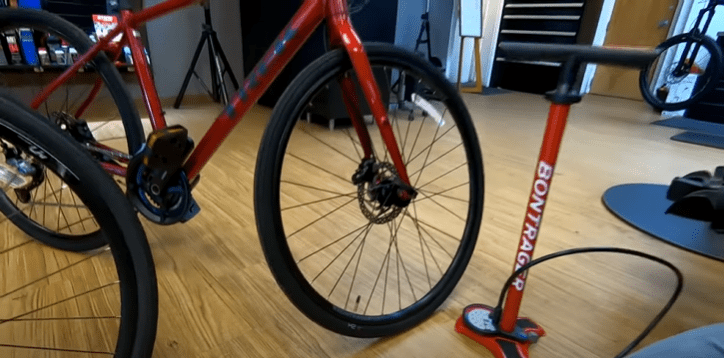

Are you aware of the correct way to inflate a bicycle tire to the appropriate pressure? At the beginning of cycling events, it’s common to hear questions such as “What pressure did you put in the front and back?”.
When it comes to the recommended limits by brands, should the handlebars be raised to their maximum or kept within the lower range?
Unfortunately, answering this question isn’t easy as various factors come into play. Whether you’re cycling in the woods, commuting, or riding on weekends, knowing how to properly inflate bicycle wheels can significantly ease the pedaling experience.
An under-inflated tire can make pedaling difficult as it resists and sticks to the ground, making it feel like you’re dragging yourself. Conversely, an over-inflated tire reflects ground vibrations, which can tire the cyclist at high speeds.
If you want to learn everything about the ideal tire pressure and the necessary equipment to keep with you to monitor your bike wheel’s airflow, I’ll explain everything about inflating bicycle tires.
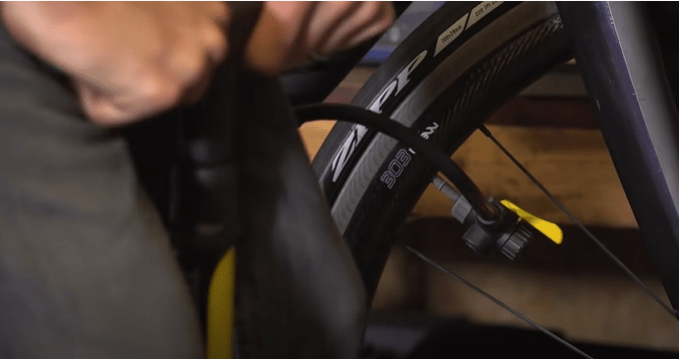

Oops! You plan on picking up your bike after a long break, but the wheels are flat. Don’t fret; this doesn’t necessarily indicate a puncture. Microcracks can cause this problem, and over time, the tire loses air, resulting in deflation.
High temperatures are also not suitable for the inner tube as the gases inside the tire expand due to the heat. This causes the tire to react in two ways: if the tire is already micro-perforated, the air escapes more quickly, causing faster deflation, or if it’s in excellent condition, it may burst, especially if it’s made of latex. In summary, your bike and the sun aren’t buddies.
After every ride, I recommend slightly deflating the tires before storing the bike to avoid overpressure. Additionally, always check tire pressure before going for a long ride, and regularly inspect the tire condition while riding around town to reduce puncture risks.
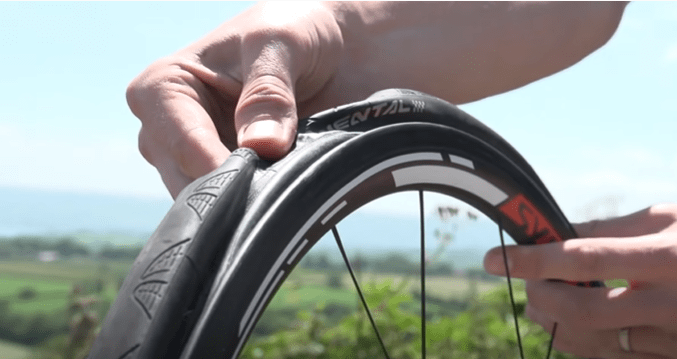

Properly inflating a tire depends on various factors, including its conditions of use.
Different types of tires require varying amounts of air volume and pressure. For instance, a 25mm road tire requires different pressure levels from a 65mm all-terrain tire. Generally, the inflation pressure of a tire decreases as the width of the wheel section increases.
For road bikes, the wheels can withstand an average pressure of 6 to 8 bars, which corresponds to 1/10th of the athlete’s weight. In contrast, thick tires like those on a fat bike require pressure between 0.5 to 1 bar for very soft ground to maximize endurance.
Terrain is also crucial in determining the correct pressure for a bicycle tire. A smooth, paved road can support maximum inflation for a racing bike, but a route with potholes or a deteriorated surface requires lower tire pressure. For mountainous terrain with damaged roads, reducing the pressure by half a bar at the front of the cycle helps to maintain precision on winding descents.
For outings on trails, do not go with a fully inflated bike; leave space for irregularities to avoid stressing the chamber.
Different weather conditions require adjustments to the volume of air in your tires. The sun can cause the chamber to expand, so reduce pressure when cycling in hot weather. Wet asphalt is also risky for tires inflated to the max. Keep high volumes of bars for smooth rides with optimal weather conditions.
The weight of the cyclist also affects the ideal tire pressure. A light cyclist can start with more moderate inflation of the tire, while a massive and heavy athlete increases the general pressure of the tires. The rear wheel receives more weight, so it requires more air than the front, around 0.5 bars (a technique commonly used by pros on the road).
For bikes carrying luggage, tire pressure in the wheels should be lowered to avoid tire tears or bursting.
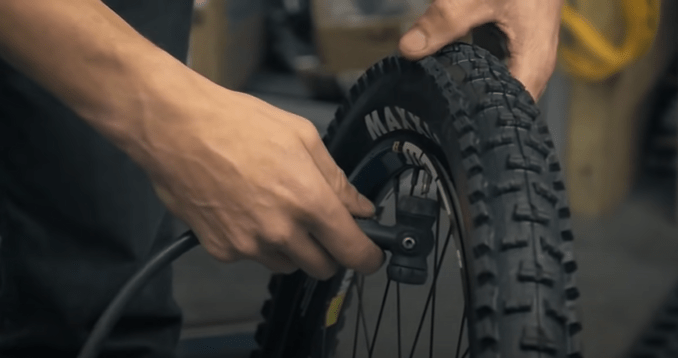

Looking for information on how to inflate your bike tires? It’s important to consider the theory that higher inflation equals faster riding, but it’s also essential to adapt to your body and cycling style. Here’s what you need to know about tire pressure and how to determine the right amount.
The best tool for measuring tire pressure is a pressure gauge. This is more precise than just feeling the tire, and it’s measured in two units: bars and PSI (pounds per square inch). A low pressure provides more comfort on natural terrain, but high pressure is better for the road as it offers resistance to wear and punctures while maintaining ease of pedaling on asphalt.
To determine the correct tire pressure, check the values given by the tire manufacturer on the sidewall. There are also online simulators that can help you estimate the right amount of pressure to inject into each wheel.
For road cycling, the 10% theory suggests that a rider weighing 68kg should push their wheels to 6.8 bars on average. Air chambers should respect a minimum threshold of 6 bars, even for lighter riders, and a maximum of 8 bars. For tubeless tires, the value may drop below 6 bars or rise slightly above the limit of 8 bars.
Mountain bike tires need to adapt to various terrains and obstacles, so it’s best to adjust the pressure accordingly. Under-inflating an all-terrain tire provides better cushioning and comfort, but be careful with thin models, as the tire may warp and detach from the rim if it is underinflated. The average value for an all-terrain bike ride is 2 bars, depending on the section of the tire and whether it’s mounted in an inner tube, tubeless, or has suspension.
For trekking hybrid tires, the wider the tire, the less pressure is needed. For example, for a wide tire with a 47mm section on an asphalt road, you can start with 4 bars at the front and 4.5 bars at the rear. Recreational cycling requires an average of 5.5 bars for stability and ease of pedaling.
Electric bicycles require a sufficient volume of compressed air for proper operation. Pedelecs have tires inflated to at least 4 bars to allow for efficient and energy-saving cycling.
Bike tires come with important markings that should be given proper attention. One of these markings is the ETRTO dimensions, which indicate the width and diameter of the tire.
However, the most crucial information is the minimum and maximum pressure ratings that the tire can handle. It is essential to avoid exceeding these values to prevent damage or tearing of the material. The manufacturers have conducted stress tests to determine the equipment’s limitations, and it is important to heed these values to ensure safe and optimal use of the tire.


If you want to inflate your bike tires, you need the right equipment. Before choosing a pump, make sure you know what kind of valve your tire has.
Presta valves, also known as French valves, have a plastic cap covering a valve that allows air to flow in and out. To inflate a Presta valve tire, you don’t need to unscrew the nut all the way. Simply press the nozzle to let air in.
You can use a pump with a nozzle that fits a Presta valve. These valves are commonly found on road bikes. They have a thin diameter and an elongated shape.
Schrader valves, also known as American valves, are hidden under a plastic cover. To inflate a Schrader valve tire, place the pump on the central point of the valve to access the air chamber. Don’t forget to put the plastic cap back on when you’re done.
Schrader valves are typically found on ATVs.
A hand pump is a classic, portable option that’s great for on-the-go inflation. They’re typically affordable and don’t indicate the current pressure for most models. However, some pumps have pressure gauges. These pumps are small and lightweight and can be attached to the bike frame or stored in a jersey pocket.
There are also specialized pumps for specific brands such as Zéfal, Lezyne, or Crankbrothers for mountain biking.
A foot pump is another option that’s easy to use. It comes with a pressure gauge, so you can easily see the pressure sent to the wheel. Foot pumps can fit both Presta and Schrader valves. You can inject more than 7 bars of air into the tire with ease.
Keep in mind that foot pumps can twist thin Presta tips.
For emergency inflation, consider CO2 cartridges. They’re fast and easy to use, and the air injection is done in seconds. However, the oxygen supplied is not as stable as the nitrogen supplied with a conventional pump. Be careful when transporting them in hot weather.
Air compressors can double as a bicycle pump. With precise adjustment, you can inflate both wheels quickly and easily in your garage. This is a practical option for family outings.
Rechargeable electric inflators are another option for on-the-go inflation. They’re like air compressors with a battery, and you can even preset the maximum pressure before inflating your bike. They can be recharged using a cigarette lighter socket or a 220V adapter.
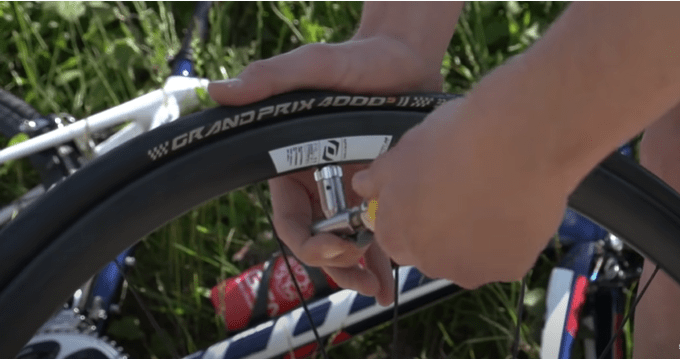

If you don’t have a bicycle tire inflation device, don’t worry! Inflation and repair stations can be found in many big cities in the USA. You can consult maps of inflation stations in places like New York and find details about repair and inflation stations in Florida, among other locations.
Another option is to go to a gas station or car wash to inflate your bike tires with a compressor. This can be helpful if you forget your inflation equipment when coming home from work by bike.
There are many different ways to inflate a tire, and the recommended pressure can vary depending on factors such as the manufacturer, tire type, and intended use. The best way to inflate your bike tires is the method that gives you the most comfort and speed for your particular riding style.
To find the ideal tire pressure, pay attention to how the ride feels and adjust accordingly. So, how much air do you put in your tires? Good luck, and enjoy your ride!
